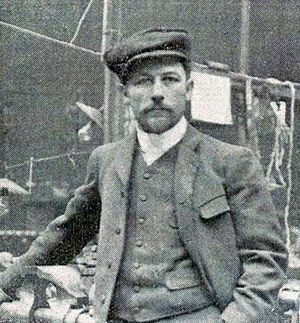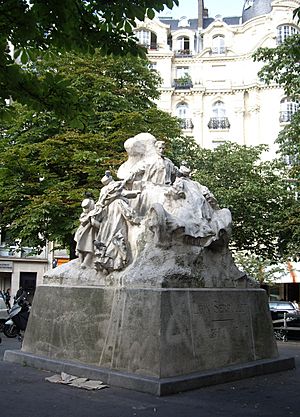Léon Serpollet facts for kids
Quick facts for kids
Léon Serpollet
|
|
|---|---|

Léon Serpollet in 1906
|
|
| Born | 4 October 1858 |
| Died | 1 February 1907 (aged 48) Paris, France
|
| Monuments |
|
| Nationality | French |
| Occupation | Engineer |
| Organization | Gardner-Serpollet |
| Known for |
|
Léon Serpollet (born October 4, 1858 – died February 1, 1907) was a clever French engineer. He invented special boilers that made steam very quickly, called flash steam boilers. He also designed and built many early steam-powered cars.
Léon Serpollet was born in Culoz, France. His father was a carpenter. Léon joined the family business with his brother, Henri. They made saws and woodworking machines. To power their workshops, Henri came up with the idea of making steam super fast. They applied for a patent for this idea in 1879.
Léon then went to Paris to study engineering. He kept working on the flash steam idea with his brother through letters. By 1886, they had created their best flash steam boiler design. Soon, they started a business building these boilers. At first, they were used for small things like lighting systems and pumps. But quickly, they began powering tricycles, steam boats, and later, cars, trams, and buses.
Contents
A Pioneer in Speed and Steam
Léon Serpollet was not just a great engineer; he also loved to drive his own cars in races. In the early 1900s, his steam cars were faster than any cars with gasoline engines. He proved this in 1902 when he set a new world land speed record in Nice, France. He reached an amazing speed of 120.80 kilometers per hour (about 75 miles per hour)!
His fast steam cars brought him many important customers. These included the future King Edward VII of England, the Maharajah of Mysore from India, and the Shah of Persia. In 1900, the Shah gave him a special award called the Order of the Lion and the Sun. Léon was also made a Chevalier of the Legion of Honour, a very important French award.
Léon Serpollet died at the age of 48 from a serious illness. After he passed away, people's interest in steam cars started to fade, especially in France. By 1908, there were no steam cars shown at the big Paris car show. However, many people recognized his huge impact on the car industry. One obituary said his genius was like that of Robert Stephenson, who invented the steam locomotive. Another compared him to Jules-Albert de Dion, a famous inventor of gasoline cars.
Today, Léon Serpollet is remembered with a statue by Jean Boucher in Paris. There is also a park named after him, the Parc Léon Serpollet, in Paris.
Serpollet Frères and Early Inventions
In 1886, Léon partnered with an industrialist named Larsonneau. Together, they created a company called "Serpollet frères et Cie." They opened workshops in Paris, in a place that is now the Parc Léon Serpollet. Léon kept improving his flash steam boiler design, changing it from flat plates to tubes. This led to more patents for his inventions.
A famous car maker, Armand Peugeot, noticed Léon's engineering skills and gave his company financial support. Serpollet then used his flash boiler to create a steam-powered tricycle. Peugeot showed this tricycle at the 1889 World's Fair in Paris. Peugeot later made several of these steam tricycles under a special agreement, calling them the Peugeot Type 1.
In the 1890s, Léon Serpollet also worked on using his flash steam boiler for tramcars. In 1897, he showed a 4-seater car and a double-decker steam tramcar to visitors from Aberdeen, Scotland, at his London workshop. A report from 1897 said that 60 Serpollet trams were already being used in Paris, with 40 more to be added soon.
Flash steam boilers are special because they hold very little water at any time. This means they heat up super fast and have a very low risk of exploding. They can also create very high steam pressures and temperatures, which makes them efficient. However, they needed a complex control system to make sure the water and heat matched the engine's needs. Léon also had to design a better steam engine that could handle the very high-pressure steam. He used special valves and a clever system to control the steam flow, which also allowed his engine to go backward.
Gardner-Serpollet Company
In 1898, Léon and Henri met a rich investor named Frank Gardner. Together, they formed the Gardner-Serpollet Company. The cars they built were very competitive against the early gasoline cars. For example, at the Bexhill Speed Trials in 1902, Léon Serpollet won two cups in his Gardner-Serpollet Racing Car. Another Gardner-Serpollet car won in the "Tourist" class.
Léon Serpollet achieved his world land speed record in April 1902 while driving the steam-powered Gardner-Serpollet Œuf de Pâques (which means "Easter Egg"). The Gardner-Serpollet company also built steam boats and showed one at an exhibition in Monaco in 1904. They also worked on steam-powered railway cars, which they called 'autonomobile' carriages. In 1902 and 1903, there were reports that three of these new carriages would run from Paris to Dijon at 100 km/hour, but it's not clear if this actually happened.
Darracq-Serpollet Company
In 1906, the Darracq-Serpollet company was created to build steam buses and heavy vehicles. Léon Serpollet was one of the managing directors. Later in 1906, a Darracq-Serpollet bus went on a demonstration tour in England and Scotland. It was very popular and could travel about 6 miles on one gallon of paraffin fuel. The Darracq-Serpollet buses and commercial vehicles used a special two-cylinder version of Serpollet's patented engine.
Sadly, in the autumn of 1906, Léon Serpollet became very ill and died in February 1907. His death had a big impact on the business, which was moving to a new factory at the time. The new factory was ready by late 1907, and many buses were made. Companies like the Metropolitan Steam Omnibus Company ordered many of them. Commercial vehicles were also built. A report in Commercial Motor magazine described the steam generator, saying it typically produced steam at 300 pounds per square inch (psi) but could go up to 900 psi!
Darracq-Serpollet made more than just buses. At a motor show in 1908, they showed different types of vehicles. These included a chassis for light vans, a chassis for buses or lorries, a 3-ton van, a lorry with steel wheels, a double-decker bus, and a 2-ton lorry.
Even though the vehicles received good reviews, the Darracq-Serpollet business was not making enough money. It was gradually shut down in 1910 and completely closed in 1912. The Metropolitan Steam Omnibus Company stopped using its Darracq-Serpollet steam buses in October 1912. However, many of these buses were sold to other companies and used elsewhere. One company on the Isle of Wight bought its first Darracq-Serpollet steam bus in 1909 and later acquired three more. These were believed to be the last Darracq-Serpollet steam buses in service before they were replaced by gasoline vehicles in 1919.
See also
 In Spanish: Léon Serpollet para niños
In Spanish: Léon Serpollet para niños



